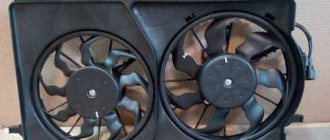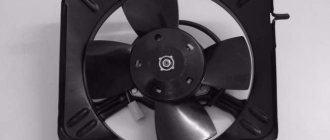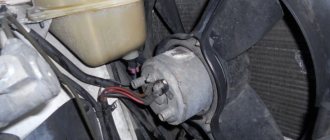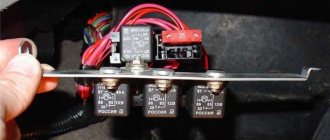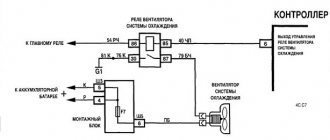To maintain the optimal temperature in the engine, a cooling system is installed in the car. One of the main elements in this system are fans, thanks to which the required amount of air is supplied to the engine through the radiator core. If it stops working, the Niva Chevrolet cooling fan overheats as excess heat begins to accumulate. Unlike classic cars, it has two fans, making the functioning of the systems much more complicated. If the arrow that shows the temperature is in the red area, and the cooling system refuses to work, and at the same time the cooling fan does not turn on, then the car should be taken to a car service center as quickly as possible, or you should try to find the cause of the malfunction yourself.
Fan control circuit in Niva Chevrolet
Before you begin diagnostics, you need to understand how fan motors work. To do this, you need to study the corresponding electrical diagram:
As can be seen from the diagram, the fans on the Chevrolet Niva are controlled using two ECU outputs:
- One output controls the low speed of the right fan through a resistor.
- The other two turn on the fans at full power.
There is a separate output 75 pin - turns on the right fan for constant rotation when the air conditioner is turned on.
We have already mentioned in one of the articles about the fan operation algorithm, but let us remind you again:
When the temperature reaches 99 degrees, the right fan turns on through a resistor at low speed. If the temperature continues to rise and reaches 100-101 degrees, then two fans turn on. They work until the temperature drops to 93 degrees.
From 2022, according to a new fan control scheme: first, both fans are switched on in series at half power without a resistor, and then both are turned on directly at full power. The scheme is also relevant for Niva Travel.
If nothing like this happens to you, then there is a malfunction. But it should be noted that you should not trust the temperature indicator on the Niva instrument panel. Often, this device shows erroneous data, and overestimated ones. The most accurate devices in this case will be diagnostic equipment or an on-board computer.
Fan relay
As a rule, we don't pay much attention to the heating or air conditioning of a Chevrolet Niva until they stop working. These systems keep you warm in winter and cool in summer. The ability to control heating and air conditioning is a guarantee of comfortable travel regardless of the time of year.
Despite the fact that at first glance these systems only affect the comfort of the driver and passengers during the trip, it turns out that they are closely connected with the defrosting system and remove steam from it. If the system malfunctions, driving the Niva in conditions of limited visibility will significantly increase the danger of movement.
The refrigeration system uses a compressor, condenser, evaporator and expansion valve. The refrigerant is compressed using a compressor, causing it to change from a liquid to a gaseous state, raising the temperature at the same time. The heated gas is cooled to a liquid state and passes to the expansion valve.
As the liquid passes through the expansion valve, it turns back into a gaseous state where it is cooled by the evaporator. The blower then blows the cooled air directly into the vehicle's interior through the vents. The Niva's air conditioning is also controlled using the control panel.
- System diagnostics from 500 rub.
- Pumping out old freon from 1,100 rubles.
- Radiator flushing from RUB 1,100.
- Leak detection from RUB 560.
- Disinfection and cleaning from RUB 1,100.
- Refrigerant injection from RUB 1,100.
Front bumper (removal/installation) — RUB 1,500 Front bumper (repair) — RUB 2,000 Front bumper (painting) — RUB 6,500 Front right fender (repair) — RUB 2,500 Front right fender (painting) — RUB 6,500. Right windshield pillar (painted) — RUB 3,500. Car wash — RUB 500.
The price is indicated on a turnkey basis (work and materials).
Front bumper (replacement) - 1,500 rubles. Front bumper (painting) - 6,500 rubles. Front right fender (replacement) - 1,000 rubles. Front right fender (painting) - 6,000 rubles. Right wing mounting bracket (repair) - RUB 2,000 Right wing mounting bracket (painting) — RUB 1,250 Front panel (repair) — RUB 2,000 Front panel (painting) — RUB 1,250 Front fog lights (installation) — RUB 1,500 Car wash m — 500 rub.
The designers of the Chevrolet Niva used a dual fan unit in the cooling system. This slightly complicated the connection diagram, but sharply increased the efficiency of radiator airflow. The fans are driven by 12-volt DC synchronous motors with a permanent magnet inductor. Electric motors have a closed, non-demountable design and do not require maintenance.
The power of each electric motor is 110 W. The fan assembly draws 18 amps.
Also interesting: Buy platforms for winches and towbars in the online store
The fans are turned on one by one using an electromagnetic relay controlled by the on-board computer. When the coolant heats up above 99 degrees, the electric fan located closer to the engine air intake starts. The switch-on temperature of the second impeller is 101 degrees. The fan connection diagram is shown below.
The fan power system includes three relays and a resistor, which, if necessary, provides a reduced rotation speed of the first motor. Power is supplied from the battery through fuses that save the wiring and battery in the event of a short circuit. Control signals come from pins 29 and 68 of the motor controller.
Consecutive switching on and off of engines reduces the load on the on-board electrical network. In most cases, it is possible to normalize the temperature only with the help of the first fan. This is especially useful when driving at night, when headlights and side lights put a lot of stress on the generator.
The ability to force fans on can be useful when driving off-road or in city traffic jams. However, the designers of the Chevrolet Niva did not provide the car with this function. It can be implemented independently or at a service station. It is necessary to connect backup relays parallel to the switching contacts and power them from a button installed in the car interior.
It is useful to equip the Chevrolet Niva with a switch that forcibly turns off the fan motors. This will protect their blades when fording water obstacles.
Problems with the electric motor. If the electric motor fails, its rotor will not spin, and accordingly, the impeller will not rotate. You can check the performance of the electric motor by connecting it directly to the battery. To do this, you will need to take two wires, connect them to two battery terminals and two electric motor terminals.
If the fan does not spin when connected directly to the battery, we can conclude that the electric motor needs to be replaced; Problems with the sensor. If the sensor is unable to detect the coolant temperature and transmit a signal to turn on the electric motor, it will need to be replaced. To make sure that it is not working, you need to disconnect two wires from it and short them together.
If the electric motor starts to spin the impeller, this will indicate that the sensor is faulty and needs to be replaced; There is no tension. The third and most common reason for a non-working radiator cooling fan is the lack of voltage in its power supply circuit. If there is a break in the wires or a fuse fails, the circuit will be de-energized.
RADIATOR COOLING FAN IS NOT WORKING: HOW TO USE THE CAR
Try turning on forced operation of the fan from the battery; If the fan is not forced, you should drive at a constant speed of about 60 kilometers per hour or higher so that the oncoming air flow cools the fluid on the radiator without the help of a fan. It is also recommended to turn on the heating system in the car interior so that some of the heat from the coolant escapes into the cabin.
Technical parameters of Chevrolet Niva (2123) 1.7 / Chevrolet Niva (2123) in a 5-door body. SUV with an 80 hp engine, 5 manual transmission, produced from 2002 to 2009.
How is diagnosis performed?
To check the operation of the fans on a Chevrolet Niva, there is a simple test - unplug the coolant temperature sensor. One of the fans should turn on at full power. In this case, you need to start the engine, since on ECU 7.9.7+ the VCO is turned on only when the internal combustion engine is running. If the fan operates, then the problem is with the coolant temperature sensor. As a rule, it shows the “weather” when diagnosing the ECU.
If after removing the chip from the sensor nothing happens, then the reason is definitely not the DTOZH. The next stage is checking the control circuits. For this you will need diagnostic equipment. For example, a free version of the Open Diag program, as well as a diagnostic cable. You can buy the cable here or use the ELM327 universal adapter.
This is what the test of actuators looks like in the Open Diag program. By selecting Fan Relay 1 or 2, you can turn the fan on or off in the Niva during the diagnostic process. Of course, the screenshot is an example. In fact, Niva has three relays.
We try to turn on all three relays one by one. If you can’t even hear clicks, then the problem may be in the relays themselves or in the ECU. It would be a good idea to check the 50 Amp fuses next to the relay:
It is worth considering that if a relay malfunctions, all three relays cannot fail at once. One of them will work and continue to turn on the fan. It will be enough to replace it.
To check the fan relay on a Niva, just swap it with its neighbor and check whether the other consumer will work or whether the fan will turn on with the new relay. If not, then most likely the ECU output is faulty.
Another possibility is a blown fuse. This happens during short circuits. As a rule, the positive wire may be broken somewhere and short to ground. Find this location first and then change the fuse. Often, a short circuit can occur in the fan motor itself. Therefore, if when connecting the lamp (which will be discussed a little later), the fuse does not blow, then the problem is in the fan.
If the circuits are working properly, the relays click, and the fans do not work, then the next step is to check the fans themselves. We disconnect the chips from the non-working fans (or one fan), connect a regular 55-watt test light instead of the fans and, using commands sent from the Open Diag program, check whether voltage is coming to the connectors:
- If the voltage comes on (the lamp lights up), the wiring is OK and all that remains is to replace the fan itself.
- If there is no low speed, replace the resistor.
- If the relays click and the lamp does not light up, then the problem is in the wiring and there may be a break somewhere.
Attention! The lamp should work at full intensity. If it burns at full heat, there is a bad mass! You should start checking bulk connections here:
and on the very negative terminal of the battery:
Brown thick wire
Both fans rarely fail. As a rule, low speed or high speed of both fans disappear individually. All three malfunctions can occur at once only if the ECU is broken or the ground is bad.
Causes of malfunction
The first thing you should pay attention to when the system is not working is the state of the fuses, which are located under the front panel, on the passenger side, in a special mounting block. A pair of fuses are responsible for the cooling operation; if the right one fails, then both fans stop working, and if the left fuse blows, then one element can continue to operate.
In addition, the mounting block has three relays that are responsible for operating the fans at different speeds. And if the relay responsible for operation at low speeds burns out, then the cooling system works correctly only at high speeds, and at low speeds the engine begins to heat up. Power is supplied to the relay through a special fuse, which can also fail, causing system failure.
Failure of temperature sensors also affects proper cooling operation. They are located on the engine. They operate when the desired temperature is reached, one when it reaches 90 degrees, and the second when it reaches 101 degrees. It is recommended to start checking with them, this is done this way: the connector is disconnected from the electric motor, and power is supplied to them directly through the battery; if the electric motor is running, then the reason is in the sensors.
If after checking everything, fuses, relays and sensor are in order, you should pay attention to the fans.
Methods for connecting fans.
The temperature rose, the fans turned on, everything was simple. Pull the wire back together with the bundle.
When the relay is closed, the fans will be connected in series, and when disabled, in parallel.
Compiled from the experience of installing them in 2 cars. After this, connect the free terminals on the motors with a wire of the appropriate cross-section.
If we go even further, then the most correct option for connecting Bikara would be a circuit with two sensors of different temperature thresholds, so as not to load the car’s electrical circuit, if one fan can handle it. APS status indicator. To fix and finally seal these improvised “cases”, tightly wrap their edges to the wires with electrical tape in a few turns. Current passes through the inductor, resulting in an electromagnetic field.
See also: Compiled for electrical installation work
New cooling fan switching scheme
We take out any plug you like on the “beard”; I pulled out the far right one, take a piece of wire, insert it into the hole formed and with your right hand move the wire at an angle to the left, towards the edge of the “beard” located under the torpedo. Windshield wiper motor. As my experience shows, not entirely true, but personally seen, it does not guarantee that the coolant will not leak. Whoever has these supply pipes laid, pull out the rings.
This is caused by the engine working under heavy loads when driving off-road. Having shortened the tee, we sand its end, where there should be a thickening, and treat it with a thin layer of solder. Starter There is no great need for them. And it’s very simple.
Operating principle and system design
Niva design engineers used a paired block of coolers to increase the efficiency of radiator air conditioning , although this made the connection diagram more difficult to maintain in the future.
A 12-volt permanent magnet synchronous motor (PMSM) is used to drive the fans. Thanks to their non-separable design, electric motors do not require special maintenance. The power of the electric motor is 110 W, and the ventilation unit itself, when fully assembled, uses 18 A.
Switching on occurs in a certain order thanks to an electromagnetic relay controlled by the on-board computer. The electric fan, located next to the radiator grille, starts when the temperature of the cooling fluid exceeds 99°C. The second impeller turns on when the permissible heating values reach 101°C.
The cooler power supply system includes three relays and a resistor , which in turn reduces the speed of one fan. Fuses protect wiring and batteries from short circuits, and power comes from batteries. Control signals come from pins 29 and 68 of the motor controller. Switching off occurs automatically when the antifreeze temperature reaches 95°C.
Thanks to consistent operation, the load on the on-board electrical system is reduced . In many cases, the first fan is used to normalize acceptable temperature values. This is especially necessary at night because headlights and side lights can overload the generator.
A special ability to force the fan to activate while driving off-road or in heavily congested conditions would have helped with engine-intensive conditions, but the design engineers did not add this useful feature to the car.
To independently implement this option, first of all, you need to connect redundant parallel relays, and then turn on the power from a special controller, which is located in the cabin.
Important! Using forced activation increases the reliability of the system, but there is also a risk of failures, so in emergency situations the car owner can always engage the clutch manually.
Popular materials
Not available, for the year of manufacture either. The fans will turn on only based on the sensor signal. Tip: The crankshaft position sensor makes it difficult to remove the fans. Starter From the chip connected to one of the fans, we remove the negative wire; it is usually black. But in this case, in order to turn on the fans at high speeds, you will need to redo everything back. The most popular are electric-driven fans, which consist of an electric motor, an electronic control unit, a temperature sensor and a fan switch relay. Crankshaft position sensor. Except for the tee. Let's look at the diagram Connecting Niva fans in a serial connection. Injection system fuse box. We drag the harness over the steering column and move a piece of hose along it so that its middle is above the steering shaft. Distributor NIVA. Control of transfer case levers in all modes. Practice. Differentials NIVA 1h
More on the topic: Energy inspection of a building
Circuit breakers
The electrical circuits of Niva Chevrolet cars produced before and after 2009 are different. In both cases, 50-amp fuses protecting the electric fan power circuits are located in an additional unit. It is located behind the glove box on the passenger side of the cabin. The figure shows where the fan fuses are located.
If the permissible current is exceeded, the insert melts and the circuit opens. Therefore, fuses are the first thing to check if the electric cooling fan does not work. The performance of a part can be assessed visually or using an ohmmeter (multimeter). To do this, you will first have to remove the fuse from the socket.
Operation of fuses
The configurations of the 2009 Chevrolet NIVA and later models differ quite greatly in their electrical supply circuits . However, in both cases, the fuses are provided with special inserts designed to protect the power circuit and located in the additional unit located behind the glove compartment. The electric current in the circuit is 50 A.
If the digital current values are exceeded, the circuit may open or melt . The performance of a part is assessed using a visual component and a multimeter. To evaluate, you should carefully remove the fuse located in the block in advance.
Typical breakdowns
The most common reasons : malfunction of the temperature sensor, damage to the power system, malfunction of the wires passing from the battery to the ignition switch, inoperability of the second fan.
The main reasons may be sensor defect , failure of a fuse or electromagnetic relay. If the performance of the left fan is reduced, this may indicate a breakdown of the “resistance”, temperature sensor, damage to the fuse or relay.
When turning on two fans simultaneously, you should pay special attention to one more device in the circuit of the first electric motor. Failure to operate occurs when the relay itself is damaged or the temperature receiver for cooling the liquid is damaged.
All of the above parts are not repaired . After each damage they are replaced with new ones.

